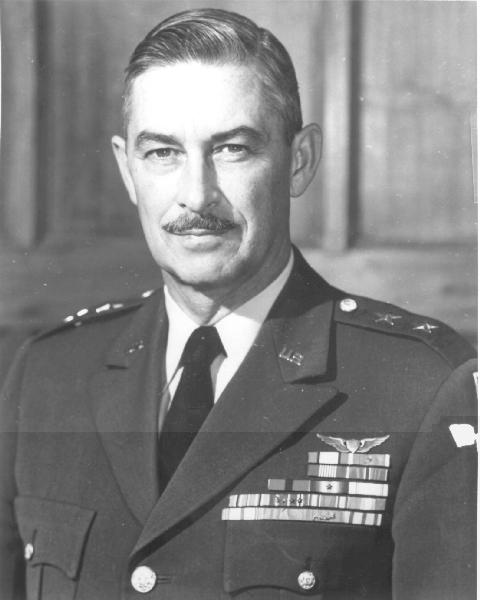Courtesy of the United States Army
John Bruce Medaris was born in Milford, Ohio, on 12 May, 1902. His service in the Armed Forces began in 1918 when he enlisted in the U.S. Marine Corps. He served in France during World War I and was honorably discharged with the rank of Corporal.
Upon his return from Europe at the close of the war, Medaris enrolled at Ohio State University, where he studied mechanical engineering. As Cadet Captain of the Senior ROTC Unit, he won a commission as Lieutenant of Infantry, U.S. Army, in 1921. he served with the 29th and 33rd Infantry Regiments in the United States and Panama until 1926, then was detailed to the Ordnance Corps.
He resigned from the Army in October 1927, and for the next 10 years, he was engaged in merchandising and management advisory work in South America and the United States.
Medaris returned to active duty in 1939 as a Captain in the Army Ordnance Corps. During World War II, he served with II Corps in Tunisia and Sicily before joining Headquarters, First Army, whose campaigns included those of Normady, Northern France, the Ardennes, the Rhineland, and Central Europe. Medaris directed the efforts of 20,000 Ordnance troops supporting the combat elements of the First Army; in this capacity, it fell to him to identify the first German V-2 rocket fired against First Army in Europe.
Until November 1955, when he was designated the first Commanding General of the newly created U.S. Army Ballistic Missile Agency (ABMA) at Redstone Arsenal, Alabama, Medaris undertook a variety of ordnance chores. During this period, he was promoted to Major General. On 1 February 1956, Medaris activated ABMA and assumed responsibility for development and production of the JUPITER IRBM missile system as well as the weaponization of the REDSTONE ballistic missile. Under his energetic leadership and forceful direction as head of ABMA, the Army also began its accomplishments in the space arena with the successful launch of the EXPLORER I satellite.
Medaris left ABMA to become the Commanding General of the U.S. Army Ordnance Missile Command (AOMC) on 31 March 1958. His command included ABMA, the Army Rocket and Guided Missile Agency (ARGMA), White Sands Missile Range, the Jet Propulsion Laboratory, and Redstone Arsenal. As AOMC Commander, Medaris was responsible for all Army Ordnance programs in rocket, guided and ballistic missile, and space fields.
During his tour of duty as AOMC Commander, additional EXPLORER satellites as well as the PIONEER lunar probes were successfully launched by the Army, resulting in significant scientific discoveries. The Army also made significant contributions toward the goal of manned space flight by launching into outer space and then recovering two living primates in May 1959. In addition, effort on the SATURN I booster program began in August 1958. The following year, NASA selected the REDSTONE for use in the Project MERCURY development flights; a MERCURY-REDSTONE carried CDR Alan B. Shepard on his historic suborbital flight around the Earth in May 1961.
Medaris retired from the Army on 31 January 1960. His dedicated efforts in the engineering and scientific fields related to guided missile development, as well as his work to create public understanding of the challenges and promises of the Space Age, marked him as one of the nation’s leading authorities on the evolving U.S. space program. He was inducted into the Ordnance Corps Hall of Fame in 1972. In 1970, Medaris was ordained an Episcopal priest and lived in North Carolina.
He was honored in May by the National Space Club and the Smithsonian Institution for his vision and leadership in the early days of the space program, as well as for his work in public awareness of the promise of the Space age.
At a ceremony at the National Air and Space Museum, the first MG John B. Medaris Award for Army Achievement in Space was accepted for Medaris by his son, retired LTC John B. Medaris, Jr., of Huntington, N.Y.
Medaris died in 1990 and was buried in Arlington National Cemetery.
Michael Robert Patterson was born in Arlington and is the son of a former officer of the US Army. So it was no wonder that sooner or later his interests drew him to American history and especially to American military history. Many of his articles can be found on renowned portals like the New York Times, Washingtonpost or Wikipedia.
Reviewed by: Michael Howard

